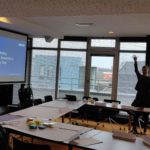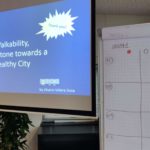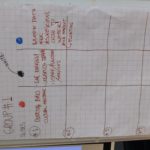In a healthy neighborhood, a pedestrian loop is a continuous and well-connected walkable surface that offers slow groups – older adults, children, and people with disabilities (cognitive and/or physical) – a safe, comfortable, and pleasant walk to sort daily errands within a 10 minute reach.
To further understand this concept, at BHL we developed street-level evaluation tools which help investigate urban health and city development issues in neighborhoods. At this urban scale, we can best (i) describe the needs and requirements of slow groups; (ii) map service priority and availability at their reach and speed by using health-GIS; and (iii) design pedestrian loops to ease daily errands and support healthier lifestyles.
With our findings, we aim to inform planners and designers on where and how to intervene with the double purpose of optimizing resources for urban development while improving population and planet health.
Welcome to read an overview of our concepts and approach, as well about a recent case we are structuring in the Netherlands.
(Cell phones – click images to enhance)
Groningen, a city with a surface area of 180.21 km² – and largest city in the north of the Netherlands – is determined to align its city development objectives towards developing a “pedestrian first plan”.
BHL offered a workshop to introduce the “pedestrian loop” concept and invite the municipality to pursue Healthy City goals; Such as, planning and designing for slow groups.
A test site was defined in the fringe of its city centre where car traffic is still dominant despite the municipality efforts and great success in transforming other parts of the city. Another major obstacle found for pedestrians is the extraordinary flow of bicycles at all times – every day! In 3 hours, policy officers, planners, designers, administrators and public health professionals of the Gemeente Groningen shared and worked together on the pedestrian loop exercise.
Towards the end, teams made short presentations on their most relevant findings, analyses, and possibilities… the case continues…
Testimonial
“I was very much taken by your approach. This way of thinking about making attractive loops (for the 60 percent) for walking is a new approach. (At the Municipality) We have drawn pedestrian networks as I showed, but this is a new way of thinking, also for me. After the workshop I started drawing loops around the Grote Markt, where we just started with an analysis and program of requirements.”
Jaco Kalfsbeek
Senior Landschapsarchitect
Atelier Stadsbouwmeester
Gebiedsstedenbouwer Binnenstad
Ruimtelijk Beleid en Ontwerp
Stadsontwikkeling
Gemeente Groningen

























We battle climate change impacts on urban ecosystems and health across different European climate zones.
Co-funded by the European Union.
We support city makers in implementing sustainable development goals with evidence.